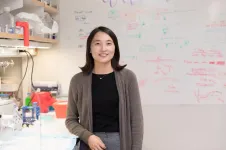(Press-News.org) Doctors may be able to predict their patients' risks of fatal coronary heart disease more accurately by taking into account the number of adverse social factors affecting them, according to a new study led by researchers at Weill Cornell Medicine and NewYork-Presbyterian.
The researchers, whose findings appear Dec. 3 in Circulation, analyzed data from the Reasons for Geographic and Racial Differences in Stroke (REGARDS) Study that tracked cardiovascular-related health outcomes in more than 20,000 people for a decade. The new analysis showed that participants who had more adverse social determinants of health, such as low income and educational attainment, were significantly more likely to die of coronary heart disease--mostly heart attacks--during the study. For example, people with three or more social determinants of health, on a list of seven, were about 67 percent more likely to have a fatal heart attack, even when accounting for differences in age and other health factors.
The researchers suggest that doctors consider using simple counts of these factors to better estimate their patients' health risks and provide more aggressive treatment where applicable.
"Physicians tend to view social determinants of health as a peripheral part of clinical care management, but we think it should play a much more central role," said lead author Dr. Monika Safford, John J. Kuiper Professor of Medicine at Weill Cornell Medicine and chief of the Division of General Internal Medicine at Weill Cornell Medicine and NewYork-Presbyterian/Weill Cornell Medical Center.
Social determinants of health have remained on the periphery of medicine, despite their potential for improving patient risk assessment, largely because no one has demonstrated an easy way to use them in day-to-day clinical practice.
"Physicians tend to be very busy people--they're unlikely to adopt a complex tool for risk assessment," Dr. Safford said. "Our approach therefore was to keep it simple."
The analysis covered more than 22,000 people, who initially did not have diagnosed coronary heart disease, in the long-running REGARDS Study, on which Dr. Safford has been a lead investigator. The stroke-focused study has included ancillary studies of heart attacks and related health outcomes.
Dr. Safford and her colleagues identified a list of nine social determinants of health that prior research has linked individually to greater risks of heart attacks, strokes and related outcomes. They found that about half (48.8 percent) of those in the study group had two or more of these adverse social factors, and that having more of them generally predicted worse coronary heart disease outcomes during the study period. Participants with three or more social determinants were, for example, about three times more likely to suffer fatal coronary heart disease, compared to those with none of these factors.
These initial findings suggested that a count of social determinants of health could be a quick and easy source of information for doctors about their patients' coronary heart disease risks--even if it is only predictive because the factors are linked to known cardiovascular risk factors such as hypertension and obesity. However, a further analysis suggested that a high count also contains an independent signal of fatal-coronary heart disease risk.
The researchers narrowed their social determinants of health list to the seven that were most strongly linked to fatal coronary heart disease: Black race, low education, low income, living in a zip code with high poverty, residence in one of the U.S. states with the least public health infrastructure, not seeing close friends/family in the past month, and lack of health insurance. They then adjusted the outcomes data based on differences in health factors, such as a greater burden of chronic disease in the high social determinants group. They still found that people with three or more social determinants had a 67 percent greater risk of fatal coronary heart disease.
A similar analysis found that people with two or more social determinants had a 14 percent greater risk of nonfatal heart attack, although that association was not statistically significant.
Noting a patient's high number of social determinants of health could enable a cardiologist or general practitioner not only to anticipate a higher chance of bad outcomes, but also to mitigate that added risk with more intensive treatment, Dr. Safford said.
"Our group has also done studies on social determinants of health and the risks of stroke, diabetes, and heart failure, and we've had similar findings in every case, so we may be close to the point where counting social determinants of health is generally adopted into clinical practice," she said.
INFORMATION:
The SARS-CoV-2 virus may enter and replicate in human cells by exploiting newly-identified sequences within cell receptors, according to work from two teams of scientists. The findings from both groups paint a more complete portrait of the various cellular processes that SARS-CoV-2 targets to not only enter cells, but to then multiply and spread. The results also hint that the sequences could potentially serve as targets for new therapies for patients with COVID-19, although validation in cells and animal models is needed. Scientists know that SARS-CoV-2 binds the ACE2 receptor on the surface of human cells, after which it enters the cell through a process known as endocytosis. Research has suggested that the virus may hijack or interfere with other processes such as cellular housekeeping ...
Chimeric Antigen Receptor T-cell therapy--CAR T--has revolutionized leukemia treatment. Unfortunately, the therapy has not been effective for treating solid tumors including childhood cancers such as neuroblastoma. Preclinical studies using certain CAR T against neuroblastoma revealed toxic effects. Now, a group of scientists at Children's Hospital Los Angeles have developed a modified version of CAR T that shows promise in targeting neuroblastoma, spares healthy brain tissue and more effectively kills cancer cells. Their study was published today in END ...
Astronomers at the Center for Astrophysics | Harvard & Smithsonian have detected the first Jupiter-like planet without clouds or haze in its observable atmosphere. The END ...
Friends are more than just trusted confidantes, say Michigan State University researchers who have examined the cultural and health benefits of close human relationships in a new study.
"Friendships are one of the untapped resources people can draw on to pursue a happier and healthier life. They literally cost nothing and have health and well-being benefits," said William Chopik, an assistant professor of psychology at MSU and the study's senior author.
Published in Frontiers of Psychology, the study is the largest of its kind and included 323,200 participants from 99 countries. Prior studies compared only a few specific cultures to one another -- but ...
The year 2021 marks the 100th anniversary of a fundamental discovery that's taught in every biochemistry textbook. In 1921, German physician Otto Warburg observed that cancer cells harvest energy from glucose sugar in a strangely inefficient manner: rather than "burn" it using oxygen, cancer cells do what yeast do -- they ferment it. This oxygen-independent process occurs quickly, but leaves much of the energy in glucose untapped.
Various hypotheses to explain the Warburg effect have been proposed over the years, including the idea that cancer cells have defective ...
CHAPEL HILL, N.C. - Many organizations are looking at effective ways to communicate the importance of wearing a mask, especially as highly transmissible new strains of coronavirus threaten to cause a surge in infections.
Experts at the University of North Carolina at Chapel Hill suggest positive messages are critical to supporting the effort.
Their findings, described in a study published in December in the International Journal of Environmental Research and Public Health, give public health experts, leaders and communicators critical insight to craft messaging that could potentially increase mask usage during the pandemic.
"As science evolved during ...
Abnormally hyperactive areas in the brain may help better predict the onset of Alzheimer's disease, according to findings of a research team led by Université de Montreal psychology professor Sylvie Belleville, scientific Director of the Institut universitaire de gériatrie de Montréal research centre.
Hyperactivation could be an early biomarker of Alzheimer's disease, the researchers say in their study published today in Alzheimer's & Dementia: Diagnosis, Assessment & Disease Monitoring, co-authored by Belleville and Nick Corriveau-Lecavalier, a doctoral student she supervises.
Worried about their memory
In their research, ...
A new study of Type 2 diabetes (T2D) in Japanese populations has uncovered a previously uncharacterized genetic variant that puts male carriers at greater risk for the disease, as well as the mechanism by which it does so. The impact of the variant was most pronounced in sedentary men; those with the variant had a 65% greater rate of T2D than sedentary men without it.
Researchers from the University of Southern California, along with colleagues in Japan, led by Professor Noriyuki Fuku of Juntendo University, found higher rates of harmful belly fat and T2D among Japanese men with a specific mitochondrial gene variant. This variant, in the site of the mitochondrial peptide ...
Researchers from LSTM's Centre for Snakebite Research and Interventions (CSRI) have led an international team investigating the evolutionary origins of a novel defensive trait by snakes - venom spitting - and demonstrated that defensive selection pressures can influence venom composition in snakes in a repeatable manner.
In a paper published in the journal Science, the team, which includes authors from the UK, USA, Australia, the Netherlands, Spain, Norway, Brazil and Costa Rica, provide the first example of snake venom evolution being demonstrated to be associated with a role in defence, ...
Scientists have created a highly detailed map of skin, which reveals that cellular processes from development are re-activated in cells from patients with inflammatory skin disease. The researchers from the Wellcome Sanger Institute, Newcastle University and Kings College London, discovered that skin from eczema and psoriasis patients share many of the same molecular pathways as developing skin cells. This offers potential new drug targets for treating these painful skin diseases.
Published on 22nd January in Science, the study also provides a completely new understanding of inflammatory disease, opening up new avenues for research on other inflammatory diseases such as rheumatoid arthritis and inflammatory bowel disease.
Part of the global ...


